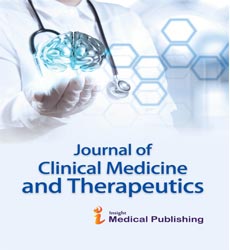Emerging Drug Therapies for Resistant Hypertension
Olivia Gabriel*
Department of Experimental and Clinical Medicine, University of Florence, 50134 Florence, Italy
*Corresponding author:
Olivia Gabriel,
Department of Experimental and Clinical Medicine, University of Florence, 50134 Florence, Italy,
E-mail: Gabriel.olivia@unifi.it
Received date: February 01, 2025, Manuscript No. ipjcmt-25-20828; Editor assigned date: February 03, 2025, PreQC No. ipjcmt-25-20828 (PQ); Reviewed date: February 15, 2025, QC No. ipjcmt-25-20828; Revised date: February 22, 2025, Manuscript No. ipjcmt-25-20828 (R); Published date: February 28, 2025
Citation: Gabriel O (2025) Emerging Drug Therapies for Resistant Hypertension. J Clin Med Ther Vol.10 No.1:03
Introduction
Hypertension remains one of the most prevalent and significant risk factors for cardiovascular morbidity and mortality worldwide. Despite advances in pharmacotherapy and public health interventions, a subset of patients develops resistant hypertension, defined as blood pressure that remains above target levels despite adherence to a regimen of three or more antihypertensive agents, including a diuretic. Resistant hypertension increases the risk of adverse cardiovascular events such as stroke, myocardial infarction, heart failure and chronic kidney disease. The clinical management of these patients presents unique challenges, necessitating innovative therapeutic approaches to achieve effective blood pressure control [1].
Description
Emerging drug therapies for resistant hypertension focus on novel mechanisms and therapeutic targets beyond conventional approaches. One key area of development is mineralocorticoid receptor antagonists (MRAs). While spironolactone and eplerenone are established agents for resistant hypertension, newer MRAs with improved selectivity and safety profiles, such as finerenone, offer benefits in reducing blood pressure and mitigating cardiovascular and renal complications, particularly in patients with chronic kidney disease and diabetes. Finerenone exhibits reduced risk of hyperkalemia compared to traditional MRAs, enhancing its tolerability and clinical utility in complex patient populations [2].
Another promising avenue involves targeting the renin-angiotensin-aldosterone system more precisely. Direct renin inhibitors, such as aliskiren, block the initial step of the RAAS cascade, reducing angiotensin II formation and downstream aldosterone effects. While initially approved for general hypertension, ongoing studies explore combination strategies and their role in resistant hypertension, particularly when conventional RAAS blockers are insufficient. Dual-acting agents that combine neprilysin inhibition with angiotensin receptor blockade, exemplified by sacubitril/valsartan, have shown efficacy in reducing blood pressure and improving cardiovascular outcomes in heart failure patients, suggesting potential applications in resistant hypertension management [1].
Novel vasodilatory and natriuretic agents also show promise. Endothelin receptor antagonists target endothelin-1â??mediated vasoconstriction, a pathway implicated in treatment-resistant hypertension and vascular remodeling. Bosentan and ambrisentan, originally used in pulmonary arterial hypertension, are under investigation for systemic hypertension, demonstrating potential in lowering blood pressure and mitigating endothelial dysfunction. Additionally, novel natriuretic peptide analogs and guanylate cyclase stimulators enhance renal sodium excretion and promote vasodilation, offering mechanistic advantages in patients with salt-sensitive or volume-dependent resistant hypertension. Advances in central sympathetic inhibition provide additional therapeutic opportunities.
Resistant hypertension is often associated with heightened sympathetic nervous system activity, contributing to elevated peripheral vascular resistance and cardiac workload. Emerging agents that modulate central adrenergic pathways, including selective imidazoline receptor agonists and novel alpha-2 agonists, aim to reduce sympathetic outflow, lower blood pressure and improve cardiovascular outcomes while minimizing adverse effects such as sedation and orthostatic hypotension [2]. Combination therapy is another strategy to address resistant hypertension effectively. Fixed-dose combinations of established and emerging agents simplify regimens, improve adherence and target multiple pathogenic mechanisms simultaneously.
For example, triple therapy combining a calcium channel blocker, an RAAS inhibitor and a mineralocorticoid receptor antagonist has demonstrated superior blood pressure control compared to dual therapy. Ongoing clinical trials investigate novel combinations incorporating emerging drug classes, optimizing efficacy while minimizing toxicity. In addition to pharmacologic innovation, precision medicine approaches are gaining attention in resistant hypertension. Genetic and molecular profiling allows identification of specific pathogenic mechanisms, enabling tailored therapy. For instance, patients with aldosterone-producing adenomas or mutations affecting sodium transport may respond preferentially to mineralocorticoid receptor antagonists, whereas those with increased sympathetic activity may benefit from central sympatholytic agents. Biomarker-guided therapy, including measurements of plasma renin activity, aldosterone levels and natriuretic peptides, supports individualized treatment selection and optimization.
Conclusion
Resistant hypertension remains a significant clinical challenge with substantial implications for cardiovascular morbidity and mortality. Emerging drug therapies offer innovative solutions by targeting novel pathogenic pathways, enhancing efficacy and improving safety profiles. Mineralocorticoid receptor antagonists, direct renin inhibitors, dual RAAS-neprilysin blockers, endothelin receptor antagonists, central sympatholytic agents and combination therapies provide diverse options for patients unresponsive to conventional antihypertensive regimens. Integration of precision medicine, biomarker-guided therapy and patient-centered approaches further refines treatment selection and optimizes outcomes. Robust clinical evidence supports the efficacy of these emerging therapies in reducing blood pressure, improving cardiovascular and renal outcomes and enhancing quality of life. While challenges such as cost, accessibility, adherence and monitoring remain, the evolving landscape of pharmacotherapy in resistant hypertension promises improved management strategies and reduced long-term cardiovascular risk. The future of resistant hypertension management lies in the combination of innovative drug therapies, individualized treatment plans, lifestyle modification and technological integration, fostering a comprehensive approach that addresses the complexity of this condition. By adopting these emerging therapies within a multidisciplinary framework, clinicians can achieve more effective blood pressure control, prevent complications and ultimately improve the health and longevity of patients living with resistant hypertension.
Acknowledgement
None.
Conflict of Interest
None.
References
- Kaukonen KM, Bailey M, Pilcher D, Cooper DJ, Bellomo R (2015) Systemic inflammatory response syndrome criteria in defining severe sepsis. N Engl J Med. 372: 1629-1638.
Google Scholar Cross Ref Indexed at
- Singer M, Deutschman CS, Seymour CW (2016) The Third International Consensus Definitions for Sepsis and Septic Shock (Sepsis-3). JAMA 315: 801-810.
Open Access Journals
- Aquaculture & Veterinary Science
- Chemistry & Chemical Sciences
- Clinical Sciences
- Engineering
- General Science
- Genetics & Molecular Biology
- Health Care & Nursing
- Immunology & Microbiology
- Materials Science
- Mathematics & Physics
- Medical Sciences
- Neurology & Psychiatry
- Oncology & Cancer Science
- Pharmaceutical Sciences
